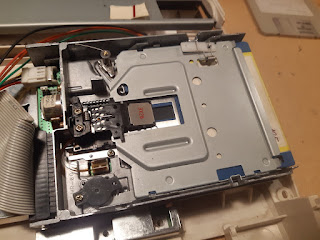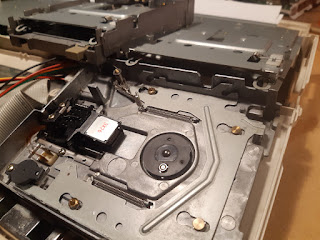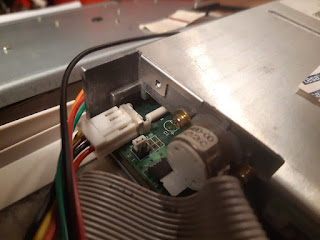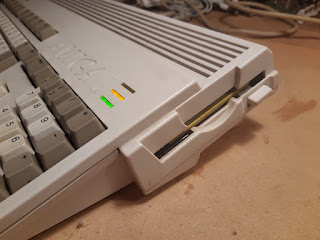Floppy drive disk detection repair - as not expected
A surprisingly simple repair to a microscopic, but essential problem with an Amiga 1200's floppy drive.
This drive didn't work reliably, and at some point failed completely, not detecting disk media anymore. Only with a little bit of extra pushing on the disk, it would click and start reading, but immediately stop when released. A more thorough inspection was required.
The mechanism didn't feel very snappy when inserting the disk, so some dirt, lack of lubrication, or worn out spring was the first guess. But it turned out everything moves nicely. Next, the "disk inserted" switch was inspected, drenched in isopropyl alcohol, tested, even resoldered, it was fine, but the drive still didn't work. Suspecting a worn out disk "sledge", that prevents the switch from getting fully pressed down, a little bending was applied to some of the metal side pieces - with no success.
 |
| Amiga 1200 floppy drive without cover plate - the slightest touch would make it work. |
Basically everything about this floppy drive was fine, only it still required some pressure on the top of the disk. With more inspection, cleaning, etc. it became a little bizarre: Only minimum pressure was required, the weight of a finger, creating microscopic movement.
The solution was found when looking at another, very similar floppy drive: The disk guides at the drive's front aren't supposed to be tilted to the inside. On the other drive, they're perfectly horizontal, parallel to the top edge.
That was a little unexpected. Amiga computers are old, this Amiga 1200's drive had the guides slightly bent, tilted towards the inside, for decades, and worked fine. But it makes sense, bent guides could prevent the disk "sledge" from fully touching down on the drive's base plate, thus not triggering the disk detection signal properly.
Bending the guides back to a (near) perfect horizontal position indeed fixed the problem.
 |
| Open drive, and disk "sledge" (top part), with straightened guides at the front. A similar drive, used for comparison, on the left. |
The lesson learned is that these guides wear out, and they were worn out on this drive. Who would've thought. They seem to hang in the air when no disk is inserted, and they're hard to see when a disk is in the drive. If you've never consciously looked at them, or even if you have, you assume they're build this way. And you probably don't expect that when they're bent down another 10th of a millimeter, they prevent the drive from working.
It might have worked for decades, and it wasn't even expected to be wrong, but still: If it's bent, it's probably broken!
 |
| Missing screw on the backside - that's acceptable. |
While at it, the casing of the drive was checked, so the sledge has no unnecessary action. This drive is missing a screw on the backside, but with a little straightening (bending... ;-) ) of the top piece, and making sure its sides fully snap into place on the drive's body, a tight fit can still be achieved.
 |
| Floppy drive immediately detects floppy disk again. Very good. |
That was a very unexpectedly simple repair. The drive disassembly was unnecessary, it probably could've been done even without opening the Amiga computer. And it even was totally analog. Awesome.